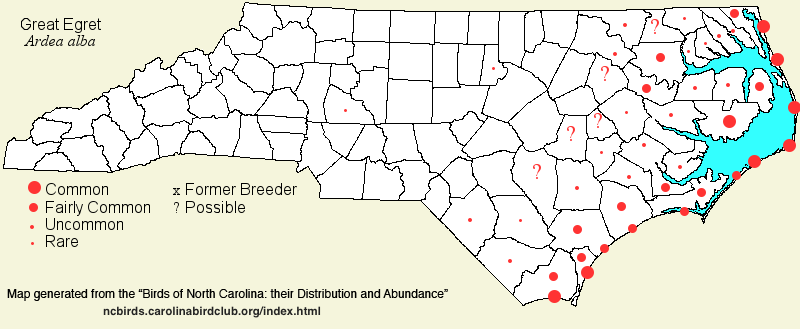 |  |
|
Great Egret - Ardea alba ARDEIDAE Members: | Search Common: Search Scientific: |
|
|
|||||||
| General Comments | The Great Egret is one of the most easily observed and identified wading birds in North Carolina, occurring in many types of wetlands across the coastal and Tidewater areas, and sporadically across the rest of the state, mainly as a post-breeder in summer and fall. It has undergone a number of scientific name and common name changes. It was named Chasmerodius albus in most of the 20th Century, and the common name has evolved from Common Egret to American Egret to Great Egret. Unlike some of our coastal wading birds, Great Egret numbers have held steady in recent decades, perhaps owing to the fact that it not only nests on coastal islands but also in swamps in the interior Coastal Plain (usually with Great Blue Herons). Great Egrets forage mostly in shallow fresh water in pools, ponds, mudflats, and lake shores, but they do feed in shallow brackish water as well as in salt water channels and pools. | ||||||
| Breeding Status | Breeder | ||||||
| NC BRC List | Definitive | ||||||
| State Status | |||||||
| U.S. Status | |||||||
| State Rank | S4B,S4N | ||||||
| Global Rank | G5 | ||||||
| Coastal Plain | Permanent resident along the coast and in Tidewater areas, with numbers increased during migration. Common along the entire coast from spring through fall, with numbers reduced in midwinter, but still fairly common to common along most of the area, less numerous northward. In Tidewater, more local in occurrence, but generally fairly common to locally common, but at best fairly common in midwinter. Breeds in colonies with other wading birds along the immediate coast, as well as locally in scattered swamp sites, especially in the Roanoke River floodplain. Farther inland in the province, it is fairly common as a post-breeding visitor, mainly Jun to Oct, and uncommon in winter and spring; breeds at a few scattered sites in the upper half of the province. Peak counts: | ||||||
| Piedmont | Primarily a post-breeding visitor; however, it breeds in a colony with Great Blue Herons in Rowan, near the Yadkin River (since about 2004). Breeding also occurred in Durham in May 2014 -- three pairs and one nest, though juveniles were never seen on later visits -- and annually into 2021. Fairly common (eastern portion) to uncommon in the western portion from Jun to Oct; common at a few areas, such as at Jordan and Falls lakes, during the post-breeding period (at least if mudflats are present). Rare in winter, and rare to uncommon in spring. Peak counts: 356, Falls Lake, 23 Sep 2010; 250, Falls Lake, 2 Oct 2009; 246, Jordan Lake (while filling with water), 9 Aug 1979. | ||||||
| Mountains | Essentially a post-breeding visitor. Uncommon in lower elevations, mainly mid-Jul to late Sep; rare later in fall (to early Nov) and in spring (Mar and Apr). Two records for very early winter: 1-2 at Beaver Lake near Asheville, 2-4 Dec 2007; 1 at Lake Junaluska (Haywood) on 10 Dec 2006. Peak counts: 12, Brevard, 31 Mar 2009; 11, Hendersonville, 28 Jul 1987. | ||||||
| Finding Tips |
The species is difficult to miss near the coast, except in late winter. Often seen inland at lakes and ponds in late summer and early fall. **** | ||||||
| Attribution | LeGrand[2021-07-16], LeGrand[2015-12-23], LeGrand[2014-12-13] | ||||||
| NC Map Map depicts all counties with a report (transient or resident) for the species. | Click on county for list of all known species. |
| NC Breeding Season Map Map depicts assumed breeding season abundance for the species. |  |